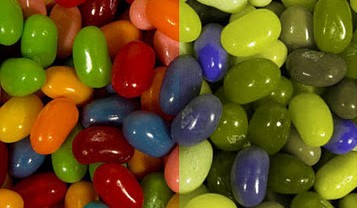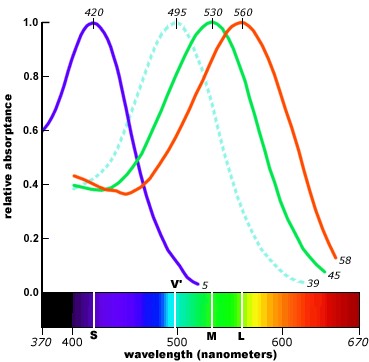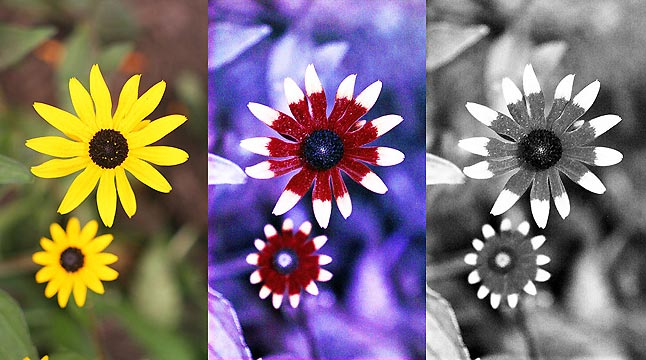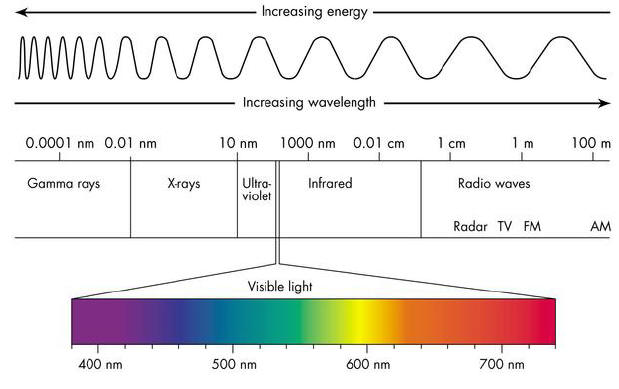Physicist: Colors exist in very much the same way that art and love exist. They can be perceived, and other people will generally understand you if you talk about them, but they don’t really exist in an “out in the world” kind of way. Although you can make up objective definitions that make things like “green”, “art”, and “love” more real, the definitions are pretty ad-hoc. Respectively: “green” is light with a wavelength between 520 and 570 nm, “art” is portraits of Elvis on black velvet, and “love” is the smell of napalm in the morning.
But these kinds of definitions merely correspond to the experience of those things, as opposed to actually being those things. There is certainly a set of wavelengths of light that most people in the world would agree is “red” (rojo, rubrum, rauður, 紅色, أحمر, ruĝa, …). However, that doesn’t mean that the light itself is red, it just means that a Human brain equipped with Human eyes will label it as red.

You can create an objective definition for green (right), but that’s not really what you mean by “green” (left).
Color is fascinating because, unlike love, its subjectiveness can be easily studied. We can say, without reservation, that a colorblind person sees colors differently than a colorseeing person.

Different people and animals see color very differently. The right side is more or less the way most other mammals, as well as red/green colorblind people, see the world.
When a photon (light particle) strikes the back of the eye, whether or not it’s detected depends on what kind of cell it hits and on the wavelength of the light. We have three kinds of cells, which is pretty good for a mammal, each of which has a different probability of detecting light at various wavelengths. One of the consequences of this is that we don’t perceive a “true” spectrum. Instead, our brains have three values to work with, and they create what we think of as color from those.

The three cones cells, and their sensitivity to light of different wavelengths. The dotted line corresponds to the sensitivity of rod cells, which are mostly used for low-light vision.
However, some animals have different kinds of cone cells that allow them to see colors differently, or see wavelengths of light that we don’t see at all. For example, many insects and birds can see into the near-ultraviolet which is the color we don’t see just beyond purple. Many birds have ultraviolet plumage, because why not, and many flowering plants use ultraviolet coloration to stand out and direct insects to their pollen.

Left: what people see. Middle: a false-color simulation of what insects may see. Right: a black and white ultraviolet only image
In the deep ocean most animals are blind, or have a very limited range of color sensitivity (it’s as dark as a witch’s something-or-other; what is there to see?). But some species, like the Black Dragonfish, have taken advantage of that by generating red beams of light that they can see, but that their prey can’t.

The Black Dragonfish cleverly projects red light from those white thingies behind its eyes, which is invisible to its prey.
It may seem strange that some creatures are just “missing” big chucks of the light spectrum, but keep in mind; that’s all of us (people and critters alike). The visible spectrum (so called, because we can see it), is the brightest part of the Sun’s spectrum. Since it’s what’s around, life on Earth has evolved to see it (many times!). But, there is a lot more spectrum out there that no living thing comes close to seeing.
Point is, light comes in a lot of different wavelengths, but which wavelengths correspond to which color, or which can even be seen, depends entirely on the eyes of the creature doing the looking, and not really on any property of the light itself. There isn’t any objective “real” color in the world. The coloring of the rainbow is nothing more than a shared (reliable, consistent, and kick-ass) illusion.
The lack of objective colorness is a real pain for the science of photography. Making a substance that becomes (what we call) yellow when it’s exposed to (what we call) yellow light is exactly as difficult as creating a substance that turns magenta when exposed to yellow light. In a nut-shell, that’s why it took so long for color photography to come along, although there are other theories:
So, it’s difficult to design film that reacts to light in such a way that we see the colors on the film as “accurate.” But, in the same sense that yellow may as well be magenta (for all that the film cares), infra-red may as well be red! You can (were you so motivated) buy infrared sensitive film that photographs light below what we can see, but above what most people call “heat” (the light radiated by warm, but not glowing-hot, objects).

A picture using film that’s sensitive to near-infrared light. This is not a picture of heat (that would use far-infrared), living plants just happen to be infrared-colored.
In fact, most “science pictures” you see: anything with stars, galaxies, individual cells, etc. are “false-color images”. That is, the cameras detect a form of light that we can’t see (e.g., radiowaves), and then “translate” them into a form we can see. Which is fine. If they didn’t, then radio astronomy would be stunningly pointless.
Infrared photo by Richard Mosse.









There is a shrimp with 16 different color receptors!
http://www.radiolab.org/2012/may/21/rip-rainbow/
Forgot about that radiolab! Well worth listening too.
Lofl ! Napalm in the morning! … i ‘love’ a good sense of humor , thanks for the chuckle and the info, as this has been a thought of mine for many years .. a perception of the mind. Very nice site!
So ive always wondered, what colour is everything? Not what are brains tell us to differentiate our personal reality, but REALLY what colour is everything. Is everything completely black? or grey? Colours to us are just the stimulation of rods and cones in the eye by light waves, which the brain processes as colours, so colours are an illusion it seems. An evolutionary trick.
My guess is the world is totally and utterly dark in reality, blacker than black. Yes there are light waves tearing around, eyes are just tools to sense it and make `something` of it. Does that make any sense?
I think you hit the nail on the head there, John. It scares me to think that our brains perceive an accurate picture of reality but not truly reality.
The better question is WHO sees the color?
Many people like to envision themselves as peeking through holes in their skull to see the real world but we know thats not true. If the photons hit the eye and are converted to signals and sent to the mind–where is the image viewed? Who views it—there is no real light inside the dark skull.
is there a “me” inside who sees it on a screen of some sorts? There is infinite regress of selfs if so. There is no way science can answer this question. If the mind is just viewed as a computer–then just as there is no one inside the computer to see the images that we see on the monitor–then there is also no one inside our brains.
Interestingly, atheist science has denied absolutely all the things we know are true about ourselves. There has to be a self behind the mind or no one can “see”. There has to be freewill for me to type even one word here without it looking like this jhf8wu f]w=0f9n 8f ue8fj .
In this rush to confirm their worst fear–that there is Creator–they have denied they are even real. That they have a logical opinion. Multiverse, Matrix etc..anything to deny what every culture on earth has known for all of history.
First of all, atheism is the lack of belief in God, nothing more. I am sure there are atheists who do believe in the soul, free will, etc. Even if you are right, and there is a ‘self’ behind the eyes, it’s still a leap to conclude that a Creator put it there. How do you justify that logic leap? One could argue that the atheist position could theoretically be more in favour of the free will position, anyway – surely there is more determinism in a universe governed by an all-powerful, omniscient God? I’m sure you’ve heard many Christians ponder about “God’s plan” for them; well, atheists don’t have plans mapped out for them. I don’t claim to speak for all atheists – many would dispute the definition of ‘free will’ I’m using here – but I’d like you to be aware that atheism doesn’t automatically denote nonbelief in free will and other philosophical and spiritual concepts that are not directly related to the issue of Creationism.
The brain is a computer. There is no ‘self’ ‘inside’ the computer; the self is the product of the computer. If I were to strike you in the skull with a hammer (which I don’t want to, but bear with me!) and cause you severe brain damage, reducing you to a vegetable-like mental state, in a sense you wouldn’t be ‘you’ any more. The things that make your ‘self’ what it is – personality, higher reasoning, memories, etc – would be lost with the destruction of the brain.
Even if it were true, though, that scientists have decided that they themselves “aren’t real” – well, so what? Your argument is starting to go round in circles. Who are you arguing with, then? You might want to back up a little bit and reevaluate some of what you’re saying. 🙂
Okay, Mike let’s look at it another way. What about the martial Artist’s Chi? I am a long time martial artist and I can tell you that many do not see the brain as the reservoir for a soul, spirit (whatever you prefer). Destroying the brain is a matter of the destroying one of the vtial points thus interupting the flow of energy. Our body is made up of specific units and minus any one of them and we die. The heart is not a brain yet no matter what the brian issues if the heart has stopped….The ‘life energy’ is not a product of the brain alone but a mixture of ‘signals’ which in the end is as unique as the individual carrying it.
Biocentrism might also disagree with your statements.
Thanks Physicist, I liked the way you explained this. How do the substances/objects of the world absorb and reflect light in different ways in order to project waves that we perceive as different colours? Although it is my brain that interprets the light waves perceived by my eyes, how do objects consistently reflect the same light waves for me to see and why do they? Am I confusing things here (should I adopt Hobbes’s postion?!)…
That was definitely something I’d call food for thought. But this ideology that objects absorb light and reflect whatever they cannot absorb and then finally our eyes detect them as “colours” as they are designed to. Is it true? Other creatures may see them in a different way, but that’s a different discussion. The questions is, everything is “coloured” because of it’s ability to absorb light and reflect it on different angles and because of that particular reason the light they reflect, we detect them as colours?
So basically it’s just the nature of substance and it’s structure that determines an object’s “colour”, is it?
God! Please do clearify, it’s bitting me.
Why do chamaleons bother changing color if it doesn’t exist?
Because in the most important sense (that predators can see them) colors exist.
MIKE,
I’m sure you don’t check this site that I Just stumbled upon. I am Glad that you mentioned computers, because I have some understanding as I fixed many of my brothers and friends computers, when they had hardware and software problems. Computers are perhaps the best thing to relate to the human mind. While they are also the best example to prove intelligent design. My argument will be very short.
Firstly, I don’t agree with James, although I do understand the path of reasoning he took. I believe that you and I share common truths, and computers doesn’t need a “inner self” to process information. That information is processed in the processor, in humans case the brain.
Here is my argument. Humans (or as you state human brains), are complex computers.
All computers have a creator.
Therefore, Humans have a creator.
The definition of a ‘computer’ is a programmable MACHINE. So you proceed from a false assumption!
Nice article but im curious if colour is only something perceived and doesnt actually exist, then what abour colour pigmentation? What about objects absorbing light and then reflecting what hasnt been absorbed as a certain colour. Is there no subatomic play happening here?
So I don’t believe that color only exists within the mind.. All this is is a rehash of the age old “If a tree falls in the forest” thought experiment and I am one to say that it does make a sound. This whole “does something exist without an observer” mindset is lame to me. Color exists outside our minds and if you have doubts, all you need to do is ask yourself if color didn’t exist, then why did color vision evolve? There needed to be water for fish to evolve, there needed to be land for fish to evolve into amphibians on up, there needed to be air for wings to evolve, there needed to be things to see for eyes to evolve.. and so on. Just like there needed to be color in the world for color vision to evolve. That’s how evolution works, adapting to what is there..
That doesn’t mean color isn’t subjective.. it’s neither subjective or objective really, it’s relative. Relative to your biological hardware that evolved to see color. Such as your cone cells.. If you have more red cones than someone else, you’re going to be able to see more shades of red. If you’re lacking green cones, you’re not going to be able to see green.
That’s how light works.. It strikes an object and reflects back the corresponding wave length. Infrared and UV light waves are not light waves that interact with an object’s color, rather other properties. Such as a flower petal having a surface that is able to reflect UV light.
And your cone cells have actual pigment in them.. Red pigment in red cones, green in green cones, and blue pigment in blue cones. Each individual cone cell has countless pigments in it, each with varying degrees of concentration. So when you’re looking at some green grass, sunlight is hitting it and reflecting back a very specific wave length. The grass is green, but the light wave reflected back isn’t actually green in color, but it will only be able to pass through a specific concentration of green pigment in a green cone cell.. and when it passing through that, it sends the color to your brain. If you don’t have any green cone cells, there will be no green pigment to allow the light wave that corresponds to green to pass through. So there is green color to grass, a colorless light wave reflected back that corresponds to green, and then green pigment in your cone cells that matches the light wave reflected back by the grass that sends the green color to your brain for processing with the rest of the image.
So to me, color exists out in the world.. but how we perceive it is relative. Luckily for us, through our evolution we’ve developed full color vision. Although, your brain can really jack up the signals being interpreted.. such as synesthesia, that’s no reason to believe that your brain is creating more than it is interpreting.
And there is some illusion in color.. such as blue skies, blue eyes, neon lights, sunsets and rises, fire could probably be considered one. A blue sky is an illusion because all it is is scattered light waves, light waves that correspond to blue.. Neon lights only excite gas into a plasma light state that sends out specific light waves, it’s not like the gas is actually that color.
But to think that all color is an illusion is not seeing the bigger picture imo.
Not only are colors non-existent, but brightness and darkness don’t exist either. It isn’t bright under a blazing sun, and a moonless night isn’t dark.
so am a believer that colour does not
exist outside of perception. and my
atgument arises from subatomic
particles. If all all electrons are
identicle and protons too then why
should things appear in different
colours.
many chemical and nuclear reactions
occur with the change in colour.
Example the change of uraniun to gold.
uraniam is “clear” but gold is yellow.
How would loosing an alpha particle or
a beta particle change colour if it was
real.
in light of evolution animals evolved
the ability to see because there was
wavelengths of light in nature already.
we see red green and blue light but dogs
only see blue. if colour were true dont
you think they would see red and green
too. keep in mind that what i call red a
dog calls blue.
you cant argue that colour is real
because there is no emperical
demonstratable testable and
predictable protocal that can be used to
test for existance of light outside
perception.
saying colour exists beyond perception
is a metaphysical question outside the
scope of science. hope you see my
point.
You can point out that a lot of things are subject to our interpretation, but they still exist in some sense. Physics is also subject to our interpretation, but it still exists in some sense. If you use this principle to dismiss things that others find important, you’ll have to use it to dismiss things that you find important as well, such as physics.
It’s about perception as much as interpretation and presentation. Our language is too limited still to explain some of thes complexities. There is no color, it’s just our way of labeling and/or presenting the world around us. There are no green and red cones, we call them that because we don’t want to call them “receptacles for detecting photons oscillating at 560nm wave length”. Who would understand that? Eyesight is just one of six senses we have to interpret the world around us. Our yellow sun produces radio waves of certain wavelengths that we have evolved to detect, interpret, and present. Had the sun been a red dwarf, we would have evolved to detect, interpret, and present different wavelengths. We have no idea what other wavelengths exist in the universe that we haven’t detected yet. On the other hand, we haven’t evolved sensors for detecting ultraviolet frequency because there was no need for it for human survival, unlike insects who need it but don’t need to see the world the way humans do. And this is where evolution comes in, if a human was unable to detect a predator because of say color blindness, that human would not procreate and pass on color blindness to future generations. Through evolution we have retained only the senses, and specific capabilities of those senses, that we needed to survive and procreate.
@Tommy K
mind = blown
I still don’t understand how we perceive color. If it’s both real and largely in our brains then how much is actual and how much is in our brains? If we are all perceiving it differently (my green is different from your green) then how did we agree to construct the world? For example, if someone said, “Let’s make these curtains in the museum purple” how did everyone agree what purple was? How did the world (except for colorblind people) come to see everything as much the same? Or are we seeing much the same or is it relative to the person doing the viewing? Did we (the human race) collectively and over time create color or was it always there, we just didn’t know what to call it?
It is impossible to know how others percieve colors, or anything else. We can make up a word, and point to something that has some objective light absorbtion characteristics. We agree that when we percieve something with those characteristics we say that word. That says nothing about what you experience, merely that we agree on the lable for the consistent thing we both experience in whatever ways.
@cryptographer – You are absolutely right, same goes for every sense and every feeling.
Have you ever argued with your spouse about whether a color is a shade of green or shade of blue? 🙂
One of my favorite sayings, and my employees, especially in sales and CS, have heard it often, is: “perception is reality”. This was mainly used to illustrate to my employees that what the customer perceives to be the reality IS reality for them, hence, to be successful we must adapt to customers’ reality. But now I see that this saying is far more reaching. If our senses allow us to only perceive the reality in a unique way that is based on our uniquely tuned senses and past experiences (yes, our past experiences shape the way our brain analyzes the world around us – for more info see Brain Games (S1, E1), an excellent episode), then each and every one of us perceives the reality in a unique way.
Have you ever tasted a glass of wine that is supposed to evoke essence of berries, roses and chocolate? I haven’t, but plenty of people have.
Back to the original question: Do colors exist?
The answer is more philosophical than scientific. If perception is reality, and we perceive colors when we open our eyes, then, colors do exist.
Pingback: Why is the Sky Blue? The Color of the Sky is an Illusion. | Foos Solves Unified
cool I never knew but how do they know
that colors are just are our eyes
Colors exist as love exists. But if you desarm these subjects from themselfs, what topic should they carry on?
So, colors don’t really exist “out there”, just wavelengths of light. Color is just a brain perception.
But this is also true of sound. Sound doesn’t exist “out there” – it’s just vibrating air molecules. Same with smell, and taste, and touch.
Everything that we know about the world is because of information collected by our senses.
Therefore everything we know about the world doesn’t really exist at all. What we perceive as reality isn’t really real.
Well I think you are wrong I watched this tv show called brain games and it says that color is not real it just seems that way because of shadows.Do you study the brain is this true are you wrong or right I want you to give me evidence if it’s true or false.
Regarding the question of whether individuals experience color similarly, I think it’s fairly obvious that the answer is yes.
The evidence is the similarity we share in……well, everything. Setting aside distribution curve abnormalities, we all have two eyes, two ears, hands, feet, 10 fingers, and so on. Clearly there is variation in each of those examples, but that variation occurs within “sameness”. For example, there are people with two brown eyes and there are those with two green eyes. But color as a differentiator is both insignificant and immaterial with respect to “two eyes” and how they function.
Another argument is dissimilarity doesn’t sit well with evolution. C0nsider that not all colors are created equally. The “hot” colors (red, yellow, orange) grab our attention more readily than the “cool” colors (blue, green, violet). Hot colors are perceived as advancing while cool colors are perceived as receding. One theory is that this enabled our ancestors to readily discern red and yellow fruits against a backdrop of cool colored green foliage, a pretty big benefit back in the day. (Interestingly, yellow is perceived as irreducible but isn’t). Also, hot colors may have made it easier to spot and avoid predators (lions and tigers, for example).
The point is that allowing for your red is my green, you have to also allow for your “hot color” is my “cool color.” Of course that sort of dissimilarity can happen but it’s genetic influence doesn’t spread very far since the disadvantaged ends up being lunch for a predator or fertilizer for fauna.
Another argument for similarity is how DNA replicates and mutates. Changes that survive and enter the gene pool occur as tiny beneficial mutations which can mutate further with incremental benefit and so on. For each of us to experience color differently, or even just a couple hundred groups who perceive color differently just doesn’t hold up with replication via DNA. That sort of variation is the equivalent of an equal chance of having 2 – 100 arms or 2 – 60 eyes with all the variations equally represented in the population. Just doesn’t work that way.
how do you know that the color does not exist?
you have left the brain your know?
THERE IS a color, if it did not exist you would never see color.
Light reflects the object’s color, and your eye interprets according to what you can, there is a filter, however, there is color, there is the blind who see during an episode of NDE, and see colors.
THIS IS SEMANTICS, NOT PHYSICS
so your mathematical masturbation doesn’t work to know if there is or not color. OBVIOUSLY THERE’S COLOR. PERCEPTION IS NOT REALITY
We have no reason to think that colours do not exist outside our brain. What actual experiment or experiments has revealed that the external world is wholly divest of any colours?? The answer is none at all! It was simply *stipulated* that the world is wholly quantitative at the birth of modern science in the 20th Century. This belief is a consequence of an implicitly held philosophy — the mechanistic philosophy — not a discovery about the world.
Here’s what I see: an object with certain texture or surface has the ability to absorb or reflect light energy. I wonder if you understand the rainbow colors and all that. Different light color possesses different wave length.
For an object to properly projects it’s true color to a percieved eye the luminance of the the light has to be at an ambient brightness (not too dim or too bright). I truely believe that an object does possess a color that we see. Some how scientists seem to believe that the object you see has no color at all. I don’t want to rub you the wrong way now. But I can be wrong as well. Here’s what I see, on this subject. I Believe that because any object has it’s own true color, it is the light(s) energy that it absorbed and reflected that plays a role in how we percieve color. What we see is a mirror reflection of what’s in the open surrounding area, the reflection collected on the lens of our eye, similar to a camera lens. In order for us to process the information our eyes have special light/dark sensor nerves that turned what was reflected on our lens into significant informations and send that informations (raw unprocessed information) to our brain to be processed. Our brain has no special trickery that could turn the object we see into color by utilizing the different energy of light or it’s different wavelength into the color we see. That’s what I understood explained by optics specialists. Make sense. Now the informations from your eyes are sent into our brain and going all over the places in our brain. Scientist couldn’t pinpoint to just one special area that our brain process colors. They can scan the brain, and see that the back part of the brain is more active for visual but what they also see is that the brain seems to have minute activities all over too.
Source(s):
College Biology psychology.
It is simply not true that all color is subjective. Were it so, color would lose most of the meaning we ascribe to it.
I happen to be partly colorblind, and sufficiently so that a great many green traffic lights have an effectively white appearance. This can cause perceptual confusion at night, when I will occasionally not realize that I have “run a green light” until I am already partway through the intersection! While highly disconcerting, this experience fortunately is quite harmless.
Yet when stopped at similar intersections for a red light, when the light changes from red to something else, I know that it has changed from red to green not due to any experience of greenness on my part, but rather due to other cues – such as the absence of redness or yellowness, and the presence of the new illumination at the top of the the semaphore, and especially the simple fact that is was a transition away from red, and the understanding that the colors happen in a known sequence. In this way, I know that it is a green light with more than sufficient reliability to drive safely.
If however tomorrow I were to remain parked at the intersection when the light changes from red to something else, due to an absence of any personal perception of greenness, should I give the police officer your name Melissa, and that of SciAm’s Michael Moyer, as published authors who might be willing to argue that a green light is not a green light?
Human’s spectrum of color is relevant only to us and our ” human” interpretation. We can measure the spectrum and “identify” the color but really only as it relates to receptors in our human eyes and brains, not objectively. Someone mentioned the old trope about “if a tree falls in the forest does it make a sound if no one is there to hear it?” Well of course it does not. It creates waves, not sound because the word “sound” is normally what we call the effect of those waves on human receptors in the human ear. It seems to me that color functions the same way in our world.
Of course the tree does make a sound, but there is nobody to listen, “humans” are no special in the Universe. and OF COURSE color does exist in the world, OBJECTIVELY.
There is a definitive color in the objects, what changes is if someone has different cones they will perceive color WRONG. Color is not just “wavelengths” without appearance. (the coloured object has the appearance of color, that’s why we see appearance of color) , without the color appearance existing in the object first, you would never see it later, that’s how it works, any place which reflects light, will reflect the whole image already with color (with or without eyes to catch and brains to “perceive”) If you have a disease in the brain’s part of perception of color, you’ll never perceive/understand the color that eyes are seeing.
Color, is caught by the eyes (and then perceived in the brain. The brain does nothing, just perceives/processes. I’m studying this area and I know a lot about it, I’m ready to get my PhD. and really upsets me when someone says about color/wavelenghts and objective world, without really understanding it. and knowing the difference about perception/reality.
Obviously color do exist in the objective world, without color existing first we would never see the appearance of color later. It’s all dark and electricity in the brain, there are no “images” in the brain, the brain can’t create something from “nothing”, It NEEDS the objective reality and all appearances.
There has to be an objective world, for if it is all an illusion than it wouldn’t be nor make sense. We need the objective world to create a subjective one, Our minds don’t create if not by the objective reality (blind as an example), for we can not fathom a new color, or imagine a completely new and alien sound, unless without experiencing it first. The world is full of subjective illusions, yet the objective world itself isn’t. We see exactly how it is.
There is clearly only ONE color in every object. and if you have all of your cones/cells working properly you will see the world as it is. If you have a slight difference (in your biology) you must see different contrasts in your surroundings, but, the color still there. (blue gold dress as an example)
Cerebral achromatopsia is another proof that color IS NOT created in the brain, people with this disease has a problem in the part of the brain responsible to process color, and do you know what happens? NOTHING, they will continue to see color, but they won’t be able distinguish or understand that RED is RED, and BLUE is BLUE (qualia)
1. Why do chameleons bother changing color if it doesn’t exist?
2 If colour is only something perceived and doesnt actually exist, then what about colour pigmentation?
3. What about objects absorbing light and then reflecting what hasn’t been absorbed as a certain colour?
Of course color is objective, and no discussion about that, but how we perceive it (qualia) is entirely dependent of the brain, but the appearance of color is ALWAYS in the object.
Pingback: What Color is the Word Color? | Abdul Diaz
To end that discussion. This blog explains it perfectly why all colors exists and they prove with evidences..
read: colors-do-exist.blogspot.com.br/2015/08/colors-exist-proof.html
Pingback: Eves Seminar : Colour | laceywallinteriordesign
A simple way to think of it is to think of your eyes as antenna. They capture light waves of different wavelengths and send electrical impulses to the optic centre of our brain where it gets converted into image. The brain does this about 60 times a second. Light waves themselves have no color. In fact color is not a property of any object. Objects merely reflect or absorb certain wavelengths of light and our brains interpret these wavelengths as different colors.
A T.V. antenna receives radio waves and sends a signal along the rv cable to a television which converts it into picture. So to answer the question, does color exist? Yes it does. But it does not exist objectively. It exists only in the mind.
Does a tree make a sound if it falls in a forest and nobody is there to hear it?
No. It only makes sound waves. Without something to detect those waves and convert them into sounds, no sound will exist.
No furyan5 , it does exist objectively and subjectively. Mind can’t create color out of nothing. we are perceiving, not creating.
Perhaps the words we are using are imprecise. I would suggest that light spectra exist objectively but that “Color” as a perception is subjective, specific to how our eyes work, and might even be very different experiences for other people.
where can I read more about this?
I get what ur saying but I disagree that color is entirely subjective. I do believe that there is objective color formed by breaking down light and absorbing/reflecting light by pigments. I think the color people usually see something as is the objective color of that object
i think there is no specific colour to anything. we dont see the reality. we just assume what we see is real
If the connection to the “real” world is only through the senses, which is the case, one can only experience the simulation/approximation of the “real” thing within its skull. Even more, how can one be sure that the senses/nerve cells didn’t trick him/her and misinterpreted or misdecyphered the information (the light/image/sight, for example) from within the “outer” realm. If that is the case, it is the same as if one was imagining the whole thing (color, objects, sounds, interactions, self/other).
Pingback: Colors | Hardcore Zen
Why water look cou;orless?
@Muhammad Shuraim
Because most light goes through water without issue. It does absorb a little red light, which is why lakes and big pieces of ice are blue.
This is the same article in Arabic enjoy it
http://wonderwall4all.blogspot.com/2018/02/do-colors-exist.html?utm_source=dlvr.it&utm_medium=facebook&m=1
What I found most disturbing about colors is that we say leafs are green, and associate leafs as “being green”. Yet the fact is that leafs (green ones 🙂 are any color but green. We see and assign them a property based on what they have not. A good mirror, what color is it? Totally (well, not totally but almost) black. It can hold on to any light. I recalled the day I discovered that all the colors I liked where because of association to the things I love (yellow, brown, green) only to realize those objects of love care about every color but those. Does anyone like a person by its poop? Of course, for things that emanate light love is more straightforward.
Pingback: Feelings and colors ~ quietlycourageous.com - Creative writing of Tonia Czopowicz